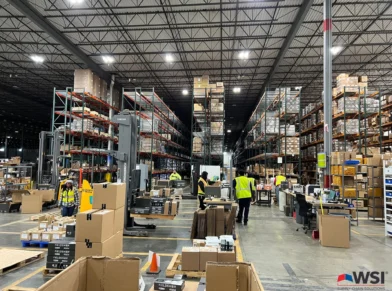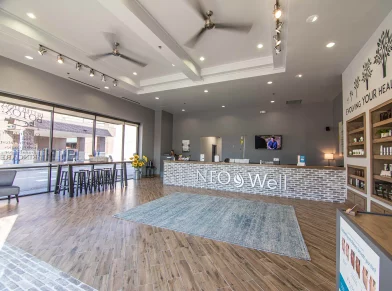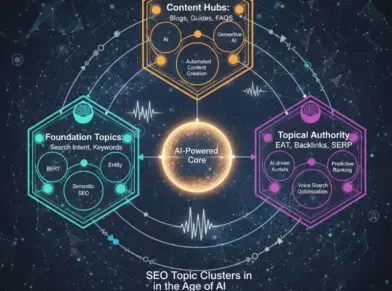Your Go-To Content Optimization Checklist

Content is the lifeblood of digital marketing. It attracts, engages, and persuades, eventually turning prospects into loyal customers. Content optimization is the process of fine-tuning your content to make it more appealing and actionable. The goal is to improve not only the content’s search engine discoverability, but also its potential for engagement and conversion.
Below we explore the ultimate content optimization checklist for boosting your marketing performance. These steps go hand in hand with the content tips outlined in our Conversion Rate Optimization guide.
How Content Optimization Works
To drive user engagement, content is optimized to resonate with the audience, cater to their needs, spark interest, and motivate them to act. In fact, you’ll appreciate that user experience is a priority right from the top. Content optimization begins with comprehending your audience and their needs, with keyword research providing insights into their interests.
This is the data that guides the subsequent content creation process. Our content optimization checklist will help you draft high-quality copy that is not only compelling, but also structured for easy readability and navigation.
That’s not to say that content optimization ends when you publish the pieces. As you’ll learn from our content optimization checklist, this is a continuous engagement that demands constant monitoring and fine-tuning of your copy. You’ll be using tools like Google Analytics to track the performance of your content and identify possible areas for improvement.
The Content Optimization Checklist
A content optimization checklist outlines the roadmap that you’ll use to maximize your content’s search engine visibility and user engagement. It smoothly integrates into your marketing processes, where it shapes your content creation from both a technical and strategic standpoint.
For instance, in our content optimization checklist, you’ll find a methodical blueprint for keyword research. This is what shows you how to center your content around the terms that resonate with your audience’s searches.
The checklist also emphasizes content quality. It details the technical procedures for not just creating engaging content but also delivering value to your audience.
Our content optimization checklist additionally comes with guidelines for enhancing the user experience. You can follow them to simplify the navigation and keep your content easily readable. Mobile optimization is another focal point of the checklist, as it ensures that your content is readily accessible and perfectly modeled for mobile screens.
You even get a roadmap for distributing content to the largest possible audience. Then to top it all off, the checklist integrates monitoring and analysis schedules, which should help you in tracking your content’s performance.
Keyword Research and Usage
Keyword research is the foundation of content optimization, as it uncovers the keywords that your audience has been using to scan through the web for information, products, or services in your niche. You’ll get clarity on your audience’s interests, queries, and linguistic preferences, along with keywords your competitors are exploiting.
Some of the tools that you could use for the job include Google Keyword Planner, Ahrefs Keyword Generator, Moz Keyword Explorer, or the SEMrush Keyword Magic Tool. These tools generate and assess keyword ideas based on search volume, difficulty, intent, and relevance.
Once you’ve identified keywords, here’s how you should integrate them into the content page for maximum impact:
- Start incorporating your primary keyword early in your content, preferably within the first 100 words.
- Use the keywords in your content titles, headings, body text, meta tags, and URLs.
- Pay attention to the questions prospective buyers are asking on social media and create content around them.
- Avoid keyword stuffing; place keywords within the natural flow of the content.
- Use long-tail keywords to target variations on popular searches.
- Regularly update your keyword strategy based on current trends and audience interests.
- Avoid targeting the same keyword on multiple pages to prevent keyword cannibalization.
- Insert Latent Semantic Indexing (LSI) keywords in your content to help Google understand the context.
- Keep the URLs short, descriptive, and include your target keywords.
- Optimize your content for voice search by incorporating conversational keywords and questions.
Quality of Content
For easy readability, your content should maintain clear and concise language, employ active voice and second-person perspective, plus infuse storytelling and emotional appeal, all while avoiding grammatical and spelling errors.
You might also want to make the text scannable by partitioning it with images, videos, charts, headings, subheadings, bullet points, and lists.
Here’s are some guidelines to keep in mind:
- Use tools like Grammarly, Hemingway Editor, or Yoast SEO to check and improve your content readability.
- Use original research and data to add credibility to your content.
- Align the content with your brand’s voice and style guidelines.
- Use canonical tags to prevent duplicate content issues by specifying the “preferred” version of a page.
- Structure content with header tags (H1, H2, etc.)
- Make the content long enough to provide detailed information, but not so extended that it becomes boring.
- Regularly audit your content and remove or update any outdated or low-quality content.
User Experience
Quality content is a critically important part of a seamless and enjoyable on-site experience for your users, enticing them to engage with your brand and ultimately convert.
Here are page design optimization guidelines to provide a great user experience:
- Simplify navigation with clear menus and links that guide users to the information they’re looking for.
- Keep important pages three or fewer clicks away from the homepage.
- Accelerate page loading speeds by optimizing your images, skimming the code, and leveraging a Content Delivery Network (CDN).
- Make the site accessible to people with disabilities. Use alt text with your images, attach transcripts to videos, and facilitate keyboard navigation.
- Use clear calls to action to guide users toward desired actions.
- Capitalize on white space to cut down on avoid clutter and improve readability.
- Implement structured data (Schema.org) to help search engines understand your content.
- Optimize images with descriptive file names, alt tags, and compression.
- Regularly check for and fix broken internal and external links.
- Integrate breadcrumbs for easier navigation.
- Set up a search function for convenient access to information.
- Avoid using intrusive pop-ups or ads.
Mobile Optimization
The point of mobile optimization is to make the on-site experience seamless for mobile users. This is especially critical at a time when mobile accounts for close to 60% of website traffic.
Mobile users need a highly responsive website layout that automatically adjusts to fit the device’s screen size. With a responsive site design in place, make sure you address these other content optimization guidelines for mobile:
- Optimize images, minify code, leverage browser caching, and reduce redirects to increase your mobile site’s loading speed.
- Use larger font sizes, shorter paragraphs, and bullet points to make your content easily readable on a small screen. For even better legibility, try to increase the contrast between your text and background.
- Maintain a touch-friendly design on all elements of your website – including menus, forms, and buttons.
- Since Flash isn’t supported on many mobile devices, use HTML5 for animations.
- Use Google’s Mobile-Friendly Test tool to be sure your website is mobile-friendly.
- Implement Accelerated Mobile Pages (AMP) for mobile speed optimization.
- Use a viewport meta tag to control the layout on mobile browsers.
Content Promotion and Distribution
The creation of high-quality, optimized content is only half the battle. The other half lies in getting this content in front of the right eyes.
For the best possible reach, we’d advise you to distribute it using an omnichannel content promotion strategy. You should especially prioritize social media, email, and guest blogging.
With email marketing, you get a direct line of communication with your audience. And when you send out those emails, you can expect an open rate of between 30-40% – with the bulk coming from engaged leads. You can even engage email conversion optimization techniques to drive sales directly from your automated messages.
Some of the content promotion guidelines to keep in mind here are:
- Highlight new posts or videos in your email signature to encourage people to check them out.
- Personalize your emails to make the content more relevant and engaging for each subscriber.
- Segment your email list based on subscriber interests, behavior, or demographics to deliver more targeted content.
- Use A/B testing to optimize various email elements – like the call-to-action, layout, or delivery time.
- Include clear and compelling calls-to-action in your emails to guide subscribers on what to do next.
- Regularly clean your email list by removing inactive subscribers to maintain high deliverability rates.
Social media, on the other hand, offers a broader audience and more potential for engagement. The platforms to prioritize are Facebook, Twitter, LinkedIn, Instagram, and TikTok.
While you’re at it, you should follow these principles:
- Collaborate with influencers and other complementary businesses to promote your content.
- Employ paid advertising to boost your content’s reach.
- Regularly share and promote your old content.
- Include social sharing buttons to encourage users to share your content.
- Repurpose your content across different mediums. For example, a podcast episode could become a blog post, or key points from a blog post could inspire a series of tweets.
For collaborations with other publishers, the best content promotion channel would be guest blogging. It gives you the privilege of tapping into other websites’ audiences through content features.
For the best outcome consider:
- Using content syndication to reach a wider audience.
- Repurposing your content into different formats like videos, infographics, podcasts, etc.
- Creating a content calendar to plan your content promotion activities.
- Identifying relevant blogs in your industry that accept guest posts.
- Writing compelling pitches to external publishers, with each outlining your content idea and why it would be valuable to their audience.
- Avoiding promotional or salesy content in your guest post.
Monitoring and Analysis
The final step in the content optimization process is monitoring and analysis. This is where you track the performance of your content to understand what’s working and areas that need improvement.
The likes of Google Analytics are equipped to generate detailed reports on a wide range of content engagement parameters. They show you which pages are attracting traffic, how long visitors are staying, and what actions they’re taking.
Here are some of the performance metrics that you should pay special attention to:
- Pageviews: The total number of pages viewed.
- Unique Pageviews: The number of sessions during which the specified page was viewed at least once.
- Bounce Rate: The percentage of single-page visits.
- Exit Rate: The percentage of exits from your site that occurred out of the total pageviews.
- Average Time on Page: The average amount of time users spend viewing a specific page or screen.
Start Optimizing Your Content for Better Marketing Today!
As you can see, content optimization is an end-to-end process that encompasses the entire creative workflow – from keyword research to content distribution and performance analysis. With the content optimization checklist, you’ll find it easier to not just coordinate every step, but also compose original content that resonates with your audience and achieves your marketing objectives.
If all this sounds like a lot of work, it is. If you don’t have the time or the expertise to optimize your content, the experts at Globe Runner can help. We can fine tune your content and ensure you are making the most out of every visit to your website. Place your content optimization request today!



















